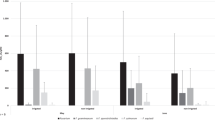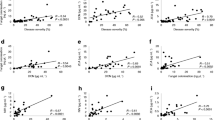Abstract
From 1997 to 1999 the occurrence ofFusarium spp. on wheat grain and its contamination with the mycotoxins deoxynivalenol and invalenol were investigated under organic farming conditions in the Rhineland, Germany. For comparison, some trials were also run under integrated farming conditions. The importance of the seed contamination withFusarium spp. as well as the impact of farming system, previous crop and soil preparation on the inoculum sources ofFusarium spp. in the soil were investigated. The data on the inoculum sources was compared to the Fusarium infection of grains and their content of DON and NIV. The crop residues in the soil were the most important inoculum source for the Fusarium species infecting wheat ears and grains. The amount of potential inoculum in the soil largely depended on the previous crop and the system of soil preparation.
Similar content being viewed by others
Literature
Parry DW, Jenkinson P, McLeod L (1995) Fusarium ear blight (scab) in small grain cereals: a review. Plant Pathol. 44: 207–238.
Obst A, Lepschy J, Beck R (1997) On the etiology of Fusarium head blight of wheat in South Germany — preceding crops, weather conditions for inoculum and mycotoxin production. Cereal Res. Commun. 25: 699–703.
Abildgren MP, Lund, F, Thrane U, Elmholt S (1987) Czapek-Dox agar containing iprodione and dicloran as a selective medium for the isolation of Fusarium species. Lett. Appl. Microbiol. 5: 83–86.
Nirenberg HI (1976) Untersuchungen über die morphologische und biologische Differenzierung in der Fusarium-Sektion Liseola. Mitt. Biol. Bundesanst. f. Land- u. Forstwirtsch. 169: 1–117.
Nelson PE, Toussoun TA, Marasas WFO (1983) Fusarium species. Illustrated Manual for Identification. Penns. State Univ. Press Univ. Park London, 193 pp.
Häni F (1979) Über Getreidefusariosen in der Schweiz: Saatgutbefall, Ährenbefall und Bodenkontamination. Z. PflKrankh. PflSchutz 87: 257–280.
Mirocha CJ, Xie W, Xu Y, Wilcoxson RD, Woodward RP, Etebarian RH, Behele, G (1994) Production of trichothecene mycotoxins by F. graminearum and F. culmorum on barely and wheat. Mycopathol. 128: 19–23.
Boutrif E, Canet C (1998) Mycotoxin prevention and control: FAO programmes. Revue Med. Vét. 149: 681–694.
Author information
Authors and Affiliations
Corresponding author
Rights and permissions
About this article
Cite this article
Meier, A., Birzele, B., Oerke, EC. et al. Significance of different inoculum sources for the Fusarium infection of wheat ears. Mycotox Res 17 (Suppl 1), 71–75 (2001). https://doi.org/10.1007/BF03036716
Published:
Issue Date:
DOI: https://doi.org/10.1007/BF03036716




